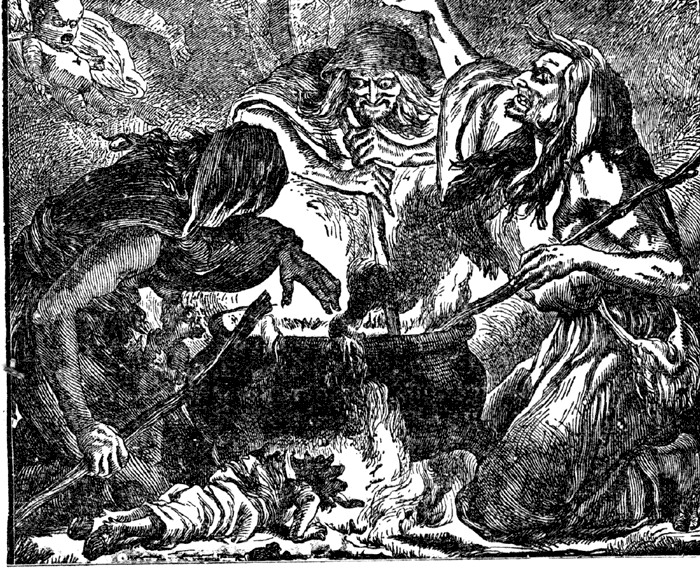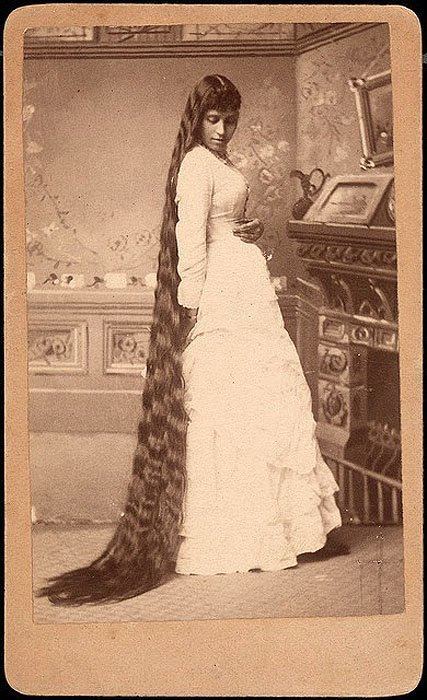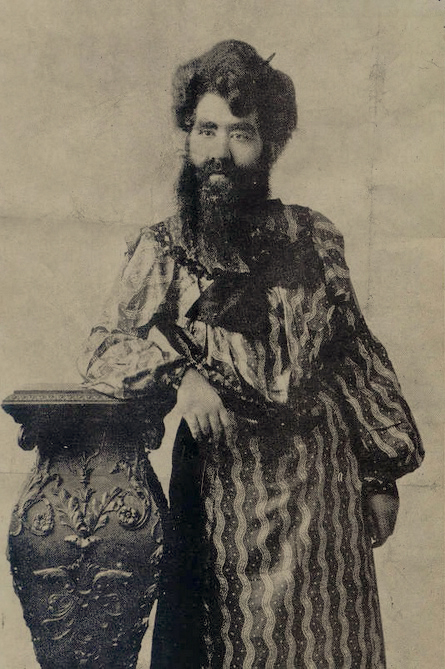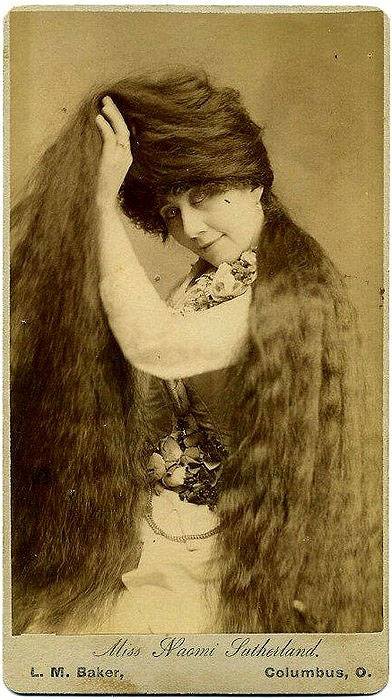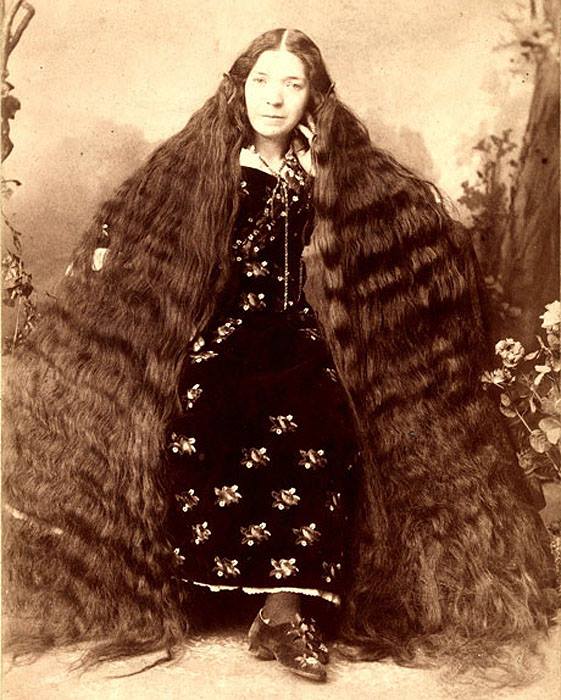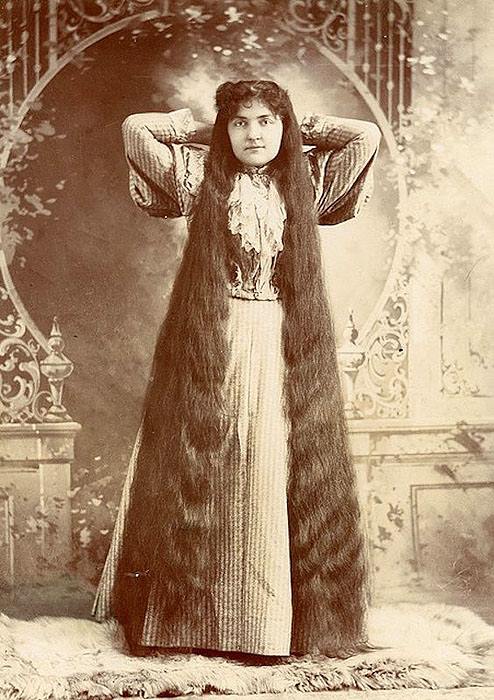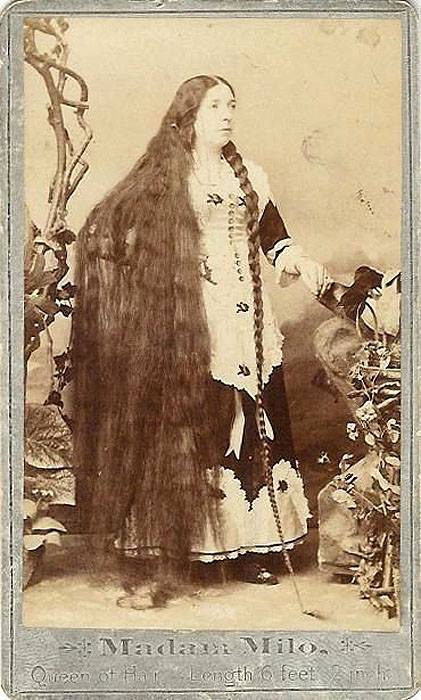Sorry I'm a Mammal - Witchcraft and Body Hair: A Long History of Interconnectedness
By Shaina Joy Machlus
circa 1890: Mrs Frampton proudly displays her very long hair. (Photo by Hulton Archive/Getty Images)
Once upon a time there lived a witch, a powerful sorceress named Rapunzel. Rapunzel spent most of her time reading, studying, and exchanging knowledge with other women; her friends and lovers; her coven. The men of the village where Rapunzel lived became suspicious. Why did all the women prefer to pass their time together, without them? What were they so entranced by? The women possessed levels of knowledge and power that were simply unattainable to the men, and they blamed Rapunzel for their exclusion and stupidity.
The men planned a crude capture of Rapunzel in order to put an end to her spell. On the night of the attack those men gathered with their weapons, as did the women and Rapunzel, informed through intuition of the intentions of the men. Bathing in the light of a full moon, the women let down their hair and chanted to their ancestors for safety. And as they did, they began to feel the ground quake, a slow and pleasing vibrational response. Below them the earth rose higher and higher and higher until it created a giant pyramid. When the men arrived, they could not believe their eyes; Rapunzel and the women waved “hello” from a tower that was almost as high as the moon itself.
Rapunzel thanked her sisters for their help by offering her long, supple beard as a ladder for their safe return to the village. The pyramid became a safe haven for the women, if they should ever need her, all they were to do was call, “Rapunzel, Rapunzel, let down your hair, so that I may climb thy bearded stair”.
Rapunzel was, of course, far from the first witch to actualize the power of their own body hair. Being a witch has always meant operating outside of the system, outside of cultural norms and expectations. Basically, witches just don’t give a fuck. During the medieval ages, that violently condemned sexuality, witches were literally getting off on brooms. It should come as no surprise that they also raised their middle fingers equally as high to beauty norms.
Not unlike modern images, Medieval and Renaissance art idealized hairless bodies. In contrast, conjure up the most stereotypical image of a witch; riding a broomstick, frizzy hair jutting out of a pointed hat, a wart on the nose and of course a few powerful hairs sprouting from said mole. Not quite The Birth of Venus. Witches open up a totally different way of being a woman, looking at this history allows one a unique insight into womanhood that strays away from the male, heteronormative gaze. And this history of witchcraft cannot be told without body and facial hair, which was prized in its multitude and length.
“Here in Europe it used to be thought that the maleficent powers of witches and wizards resided in their hair,” writes Sir James Frazer, a British expert in medieval folklore. If there is one thing we know white dudes are afraid of, it is most definitely liberated women with maleficent powers, am I right? So, naturally with the existence of witches began the quest to destroy witches. It was thought that without their hair, they were powerless; “...nothing could make any impression on these miscreants so long as they had their hair.” In witch trials it was common practice to shave the head and whole body of witches in order to obtain confessions.
This practice continued throughout the witch hunts of 17th century Europe and America (think Salem witch trials), where there was the popular belief that, witches, being the servants of the Devil, always carried a Devil’s mark; be it a mole, boil, birthmark, tiny freckle, etc. And where is the most risque (and therefore likely) spot for such branding? The pubic hair of course. Although this was clearly an attempt to punish women for having distinguishing features it unfortunately did not stop many witches from having their pubic hair shaven, not only as an act of disempowerment but also to discover hidden “marks of the devil”.
“The enemy is never our own bodies but those who tell us there is something wrong with them.”
A nude woman with long dark hair strikes a graceful pose, circa 1900.
Clearly in awe of the nether regions of these wild women, this fascination with witchery and pubic hair continues to be referenced in many texts throughout the Medieval period. Besides the ability to grow hair, many people thought pubic hair itself contained magic. De Secretis Mulerium, translated as Women’s Secret, is an important book from the Middle Ages that was created to inform men about the “ways of women”. The guide contains more than a few references to women’s body hair and perverse witchery. One of the most interesting being the tantalizing recipe that claims by taking the pubic hair from a menstruating woman, burying it in fertile earth and heating it up a bit, one can produce a serpent. Steer clear. Or don’t.
Pubic hair was also a common ingredient in Medieval potions, according to a variety of texts. Mixing together honey, mead, mandrake root, rose petals, and pubic hair could produce a potent charm that would cause the eater to fall in love with the owner of the recently digested hairs. Across the world, in all types of magic, including voodoo and hoodoo, witches used pubic hair as an especially robust ingredient for spells.
Even Shakespeare himself could not resist the allure of witches and hairiness. The tragedy Macbeth features three witches, who happen to be some of the most colorful characters found in any of his stories. Besides being “withered”, having “skinny lips” and “choppy fingers”, Shakespeare also gives the three women beards. Scholars propose that the beards serve to blur the gender of the witches, making them all the more mystical. Is it coincidence that these witchy people, powerful enough to take down a King, also unabashadley sport their natural facial hair? I think not.
The three wayward "sisters" of Macbeth, beards and all.
Witches have always represented the keepers of an unknown world; that which could not be explained without the belief of magic. And body hair is nothing if not a mystery, right? Well, actually, not so much. Because here is the thing. Body hair is not, by any standards, an anomaly amongst women. Hairy hero Mona Chalabi writes, “about one in 14 women have hirsutism, a condition where “excessive” hair appears in a male pattern on women’s bodies”. And basically every woman and femme has at least a few thick, dark hairs sprouting from somewhere ‘random’; be it a nipple, a neck, or a buttcrack. Perhaps the real question is not why did so many witches have body hair but why aren’t all women as comfortable showing this hair off?
According to a study done by Michelle J Lipton in 2006, “women spent considerable time on the management of their facial hair (mean, 104 min/week). Two thirds (67%) reported continually checking in mirrors and 76% by touch. Forty percent felt uncomfortable in social situations”. The good news is, we are all witches! The not as good news is, looking at the legacy medieval witches left, it feels mildly unnerving to think our own histories could read something more like “socially awkward freaks constantly touching their lower chins”. Meanwhile, our witch sisters of yore spent their days doing things like studying how to be in harmony with nature and having orgasims, sometimes both at the same time.
origin of photo unknown
The current resurgence of witches and witchcraft is no coincidence; women are tired of being controlled. Women are exhausted of being underestimated, at being tricked into thinking their perfect selves are anything less. Be it body hair or wrinkles or rolls, or more profoundly skin color or genitalia or size, the enemy is never our own bodies but those who tell us there is something wrong with them. When it comes to self care and self love, we can all take a note or two from the wildness of medieval witches.
Maybe Rapunzel did not actually exist, but witches did and many of them suffered greatly for their beliefs. Being comfortable with body hair is tough in a culture that worships prepubescent, hairless bodies (says the writer who has had almost every form of body hair removal under the sun). But who said witchery was easy? So dear hairy witch, tweeze and wax to your heart’s content (your body, your rules), but know that no matter what beauty norms tell you, those hairs connect you to a history riddled with badass, bearded, broomstick-loving sorcerers.
Photos sourced from 38 Photos That Prove Victorian Women Never Cut Their Hair



